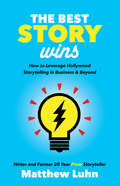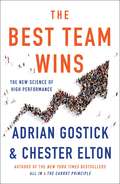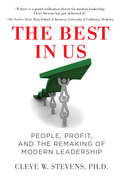- Table View
- List View
The Best Investment Advice I Ever Received: Priceless Wisdom from Warren Buffett, Jim Cramer, Suze Orman, Steve Forbes, and Dozens of Other Top Financial Experts
by Liz ClamanWouldn't you like to sit in a room and ask the following people for their investment advice? -John C. Bogle (Founder, Vanguard Group) -Warren Buffett (CEO of Berkshire Hathaway) -Bill Gross (Founder and CIO, PIMCO) -Susan Ivey (CEO, ReynoldsAmerican Inc.) -A.G. Lafley (Chairman, Procter & Gamble) -Georgette Mosbacher (CEO, Borghese Cosmetics) -John Myers (CEO, GE Asset Management) -Suze Orman (bestselling author) -Steve Forbes (President, Forbes magazine) These and dozens of other investment professionals offer their personal secrets of success when it comes to making money. And along the way, they provide their own insights on whether you should diversify your portfolio (or put your cash somewhere else), whether you should pick your own stocks (or let a pro do it for you), if investing in real estate is really the answer to great wealth, if saving a few pennies here and there really do add up, and much, much more. The book is edited by Claman to be extremely accessible to all investors, regardless of their financial background.
The Best Job in the World
by Ben SouthallThe true story of the man with the Best Job in the WorldThe Best Job in the World is the story of how following your passions can lead to life-changing opportunities. Adventurer Ben Southall shares his experiences and lessons learned as the winner of the inaugural Tourism Queensland's Best Job in the World campaign, and reveals how this has led to ongoing opportunities since. Part autobiography, part insight into the power of a unique marketing campaign, this book follows Ben's journey--from leaving the UK on his own expedition around Africa to his new role as caretaker of Hamilton Island on the Great Barrier Reef. You'll learn about the skills and experiences that shaped Ben's path, together with the inevitable pitfalls that he faced along the way to living his dream.The sole winner of the Best Job in the World campaign, Ben's perspective is a unique one to share the serious challenges that arose from being catapulted into a high profile job in an idyllic location. Humorous and poignant, the story is as much holistic life guide as travel guide, providing a motivational and inspirational tale that may just be the push you need to:Get inspired--see the opportunities around you and grab them with both handsEmbrace the unknown, overcome life's obstacles and challenge expectationsLive out your dreams and be your authentic selfClimb out of the rut and take part in the world around youIn The Best Job in the World, Ben Southall answers the questions everyone is asking: "What is it like? Is it really the best job in the world?" You'll learn how to transform your interests and passions into a flexible, long-term career, and how following the road less travelled can lead to living your best life. If you're dissatisfied, stuck in a rut or merely curious, The Best Job in the World is a must-read tale of aspiration, inspiration and motivation.
The Best Leaders Are Listeners: Lesson 6 from Leadership Gold
by John MaxwellSmart leaders learn from their own mistakes. Smarter ones learn from others' mistakes--and successes. John C. Maxwell wants to help you become the smartest leader you can be by sharing Chapter 6, The Best Leaders Are Listeners, of Leadership Gold with you. After nearly forty years of leading, Maxwell has mined the gold so you don't have to. Each chapter contains detailed application exercises and a "Mentoring Moment" for leaders who desire to mentor others using the book. Gaining leadership insight is a lot like mining for gold. You don't set out to look for the dirt. You look for the nuggets. You'll find them here.
The Best Medicine
by Bruce L. Gewertz Dave C. LoganThis volume provides a theoretical framework for visionary leadership as well as specific management techniques to achieve success. The authors focus on maintaining a consistent set of behavioral characteristics for both the leader and the organization as a whole. The text is written in a conversational style using the authors' personal experiences and case studies to illustrate the principles and practices of successful leaders. When helpful, the large body of observational work on professional group dynamics is referenced. The text also provides ideal supplemental material for the many leadership programs offered by physician organizations and health care systems Developed by an accomplished physician leader from one of the nation's finest hospital systems and an experienced professor of business, The Best Medicine: A Physician's Guide to Effective Leadership is of great value to physicians of all levels who are interested in improving their understanding of leadership styles and tactics.
The Best Practice: How the New Quality Movement is Transforming Medicine
by Charles C. KenneyIn the late 1990s, treatment-related deaths or "complications" were the fifth leading cause of death for Americans. Spurred by the crisis, a group of dedicated physicians like Paul Batalden and Don Berwick made it their goal to study the concepts of "quality improvement" used at Toyota and NASA, and to apply them to the practice of medicine. This book tells their story, and how these "heretical" ideas have blossomed into a movement, bringing the focus back to where it should have always been: the patient.
The Best Scholarships for the Best Students
by Peterson'sPeterson's The Best Scholarships for the Best Students is here to help ambitious, high-performing students get the most out of the educational process. This guide will help students find honors, awards, and life-changing opportunities. In addition to our descriptive award listings, there are also sections on writing about yourself, preparing a strong curriculum vitae/resume, and obtaining strong letters of recommendation. Peterson's also has advice for parents of accomplished students and advice from past student award winners. Peterson's The Best Scholarships for the Best Students provides expert strategies to help successful students apply for and win major academic and experiential awards.
The Best Scholarships for the Best Students--A Selection of Access and Equity-Based Programs
by Peterson'sPeterson's The Best Scholarships for the Best Students-A Selection of Access and Equity-Based Programs reviews a collection of opportunities to help people succeed in the U.S. educational system and in society. These programs include those that are designed to help underrepresented groups gain exposure to experiences that will prepare them for success. Peterson's The Best Scholarships for the Best Students provides expert strategies to help successful students apply for and win major academic and experiential awards. For more information see Peterson's The Best Scholarships for the Best Students.
The Best Scholarships for the Best Students--A Selection of Competitive Scholarship Opportunities
by Peterson'sPeterson's The Best Scholarships for the Best Students-A Selection of Competitive Scholarship Opportunities reviews a collection of nationally prestigious programs. These first-rate scholarship opportunities have been selected based on the history of each program, their benefits, and the amount of each award. Peterson's The Best Scholarships for the Best Students provides expert strategies to help successful students apply for and win major academic and experiential awards. For more information see Peterson's The Best Scholarships for the Best Students.
The Best Scholarships for the Best Students--A Selection of Top Internships and Experiential Opportunities
by Peterson'sPeterson's The Best Scholarships for the Best Students-A Selection of Top Internships and Experiential Opportunities reviews a collection of cocurricular opportunities that help in the educational planning and advancement of high-performing students. The listing includes the best ways for students to plan for their experiential opportunities during college summers. Peterson's The Best Scholarships for the Best Students provides expert strategies to help successful students apply for and win major academic and experiential awards. For more information see Peterson's The Best Scholarships for the Best Students.
The Best Scholarships for the Best Students--Advice for Parents
by Peterson'sPeterson's The Best Scholarships for the Best Students-Advice for Parents provides strategies and resources to help parents mentor their child to achieve his or her academic and professional potential. It includes tips on identifying a child's gifts, becoming a child's advocate without becoming a "helicopter parent," and looking for opportunities to enhance a child's education outside of school. Peterson's The Best Scholarships for the Best Students provides expert strategies to help successful students apply for and win major academic and experiential awards. For more information see Peterson's The Best Scholarships for the Best Students.
The Best Scholarships for the Best Students--Advice from Student Winners: What's the Secret?
by Peterson'sPeterson's The Best Scholarships for the Best Students-Advice from Student Winners: What's the Secret? lets readers hear the voices of students who have had great success in applying for the types of awards described in this book. These award winners describe their approach to the application process, and they offer their own educational advice for other students. Peterson's The Best Scholarships for the Best Students provides expert strategies to help successful students apply for and win major academic and experiential awards. For more information see Peterson's The Best Scholarships for the Best Students.
The Best Scholarships for the Best Students--For the Ambitious: Competitive Scholarships and Experiential Opportunities
by Peterson'sPeterson's The Best Scholarships for the Best Students-For the Ambitious: Competitive Scholarships and Experiential Opportunities helps outstanding students understand the types of honors, awards, and life-changing opportunities available to them. It briefly covers why applying for highly competitive opportunities has value and contains a list of ten of the most prestigious scholarships for high school students. Peterson's The Best Scholarships for the Best Students provides expert strategies to help successful students apply for and win major academic and experiential awards. For more information see Peterson's The Best Scholarships for the Best Students.
The Best Scholarships for the Best Students--How to Write About Yourself
by Peterson'sPeterson's The Best Scholarships for the Best Students-How to Write About Yourself focuses on how to craft a strong personal statement. In addition, there are shorthand lists of do's and don'ts for writing personal statements that help readers further develop their writing styles. Peterson's The Best Scholarships for the Best Students provides expert strategies to help successful students apply for and win major academic and experiential awards. For more information see Peterson's The Best Scholarships for the Best Students.
The Best Scholarships for the Best Students--Interviewing to Win
by Peterson'sPeterson's The Best Scholarships for the Best Students-Interviewing to Win describes the interview process and offers advice on how to best prepare should readers be called in for an interview. It deals with what to expect, what to wear, and some basic do's and don'ts in an interview. Peterson's The Best Scholarships for the Best Students provides expert strategies to help successful students apply for and win major academic and experiential awards. For more information see Peterson's The Best Scholarships for the Best Students.
The Best Scholarships for the Best Students--Obtaining Strong Letters of Recommendation
by Peterson'sPeterson's The Best Scholarships for the Best Students-Obtaining Strong Letters of Recommendation helps students choose the best recommenders and prep them with the information they need to do a great job in writing the recommendation. It assists students in distinguishing between college and scholarship recommendations, approaching professors about letters of recommendation, and preparing letter of recommendation portfolios. Peterson's The Best Scholarships for the Best Students provides expert strategies to help successful students apply for and win major academic and experiential awards. For more information see Peterson's The Best Scholarships for the Best Students.
The Best Scholarships for the Best Students--Preparing a Strong Curriculum Vitae/Resume
by Peterson'sPeterson's The Best Scholarships for the Best Students-Preparing a Strong Curriculum Vitae/Resume walks students through the process of preparing their resumes or CVs. Examples of actual resumes and CVs are included, along with strategies for selecting what should and should not appear on a resume and/or CV. Peterson's The Best Scholarships for the Best Students provides expert strategies to help successful students apply for and win major academic and experiential awards. For more information see Peterson's The Best Scholarships for the Best Students.
The Best Scholarships for the Best Students--Scholarship and Fellowship Resources for International Students
by Peterson'sPeterson's The Best Scholarships for the Best Students-Scholarship and Fellowship Resources for International Students provides international readers with a starting point for academic and experiential opportunities located primarily in the Unites States. The listing includes a description of the international resources and their Web sites. Peterson's The Best Scholarships for the Best Students provides expert strategies to help successful students apply for and win major academic and experiential awards. For more information see Peterson's The Best Scholarships for the Best Students.
The Best Scholarships for the Best Students--Strategies and a Timeline for Success
by Peterson'sPeterson's The Best Scholarships for the Best Students-Strategies and a Timeline for Success provides an overview of the strategies ambitious students should use and the steps they should take to plan and apply for scholarships, honors, awards, and experiential opportunities. Students can help plan ahead with the timeline, or calendar, which takes them through the application steps from freshman year to graduation. Peterson's The Best Scholarships for the Best Students provides expert strategies to help successful students apply for and win major academic and experiential awards. For more information see Peterson's The Best Scholarships for the Best Students.
The Best Selling Coach: Business Development for Business Coaches, Consultants and Advisors
by Nick Davies Rebecca BonningtonWritten by a sister and brother team with 35 years of combined experience, this book demystifies business development and offers a simple and highly effective method of selling for business coaches and consultants.Selling professional services, particularly for new or aspiring consultants, can seem daunting and distasteful. This book shows that it doesn’t need to be this way and, using a four-stage process, shows coaches how to first build their confidence and go on to locate, connect and meet desirable clients, virtually or in person. This book guides readers through asking for the sale and keeping control of the business relationship as it develops. Complete with email and letter templates and LinkedIn strategies, many chapters also link to an online course which gives access to downloadable materials such as professionally designed PDFs suitable for workshops, presentations and coaching sessions.Current, new and aspiring business coaches, as well as postgraduate coaching students, will welcome this guide to solving the top issues most people face in this sector: finding new clients, building your client base and winning work.
The Best Service is No Service
by David Jaffe Bill PriceIn this groundbreaking book, Bill Price and David Jaffe offer a new, game-changing approach, showing how managers are taking the wrong path and are using the wrong metrics to measure customer service. Customer service, they assert, is only needed when a company does something wrong--eliminating the need for service is the best way to satisfy customers. To be successful, companies need to treat service as a data point of dysfunction and figure what they need to do to eliminate the demand. The Best Service Is No Service outlines these seven principles to deliver the best service that ultimately leads to "no service":Eliminate dumb contactsCreate engaging self-serviceBe proactiveMake it easy to contact your companyOwn the actions across the companyListen and actDeliver great service experiences
The Best Story Wins: How to Leverage Hollywood Storytelling in Business & Beyond
by Matthew LuhnThe Best Story Wins provides fresh perspectives on the principles of Pixar-style storytelling, adapted by one of the studio&’s top creatives to meet the needs of entrepreneurs, marketers, and business-minded storytellers of all stripes.Pixar movies have transfixed viewers around the world and stirred a hunger in creative and corporate realms to adopt new and more impactful ways of telling stories. Former Pixar and The Simpsons Animator and Story Artist Matthew Luhn translates his two and half decades of storytelling techniques and concepts to the CEOs, advertisers, marketers, and creatives in the business world and beyond. A combination of Luhn&’s personal stories and storytelling insights, The Best Story Wins retells the &“Hero&’s Journey&” story building methods through the lens of the Pixar films to help business minds embrace the power of storytelling for themselves!
The Best Team Wins: The New Science of High Performance
by Adrian Gostick Chester EltonThe New York Times bestselling authors of The Carrot Principle and All In deliver a breakthrough, groundbreaking guide for building today’s most collaborative teams—so any organization can operate at peak performance.A massive shift is taking place in the business world. In today’s average company, up to eighty percent of employees’ days are now spent working in teams. And yet the teams most people find themselves in are nowhere near as effective as they could be. They’re often divided by tensions, if not outright dissension, and dysfunctional teams drain employees’ energy, enthusiasm, and creativity. Now Adrian Gostick and Chester Elton share the proven ways managers can build cohesive, productive teams, despite the distractions and challenges every business is facing. In The Best Team Wins, Gostick and Elton studied more than 850,000 employee engagement surveys to develop their “Five Disciplines of Team Leaders,” explaining how to recognize and motivate different generations to enhance individual engagement; ways to promote healthy discord and spark innovation; and techniques to unify customer focus and build bridges across functions, cultures, and distance. They’ve shared these disciplines with their corporate clients and have now distilled their breakthrough findings into a succinct, engaging guide for business leaders everywhere. Gostick and Elton offer practical ways to address the real challenges today’s managers are facing, such as the rise of the Millennials, the increasing speed of change, the growing number of global and virtual teams, and the friction created by working cross-functionally. This is a must-read for anyone looking to maximize performance at work, from two of the most successful corporate consultants of their generation, whom The New York Times called “creative and refreshing.”
The Best Way to Rob a Bank is to Own One: How Corporate Executives and Politicians Looted the S&L Industry
by William K. BlackAn investigator tells the inside story of the 1980s savings-and-loan scandal and what we can do today to prevent future frauds: “Merits a wide readership.” —Journal of Economic IssuesIn this expert insider’s account of the savings and loan debacle of the 1980s, William Black lays bare the strategies that corrupt CEOs and CFOs—in collusion with those who have regulatory oversight of their industries—use to defraud companies for their personal gain. Recounting the investigations he conducted as Director of Litigation for the Federal Home Loan Bank Board, Black fully reveals how Charles Keating and hundreds of other S&L owners took advantage of a weak regulatory environment to perpetrate accounting fraud on a massive scale. In the new afterword, he also authoritatively links the S&L crash to the business failures of 2008 and beyond, showing how CEOs then and now are using the same tactics to defeat regulatory restraints and commit the same types of destructive fraud.Black uses the latest advances in criminology and economics to develop a theory of why “control fraud”—looting a company for personal profit—tends to occur in waves that make financial markets deeply inefficient. He also explains how to prevent such waves. Throughout the book, Black drives home the larger point that control fraud is a major, ongoing threat in business that requires active, independent regulators to contain it. His book is a wake-up call for everyone who believes that market forces alone will keep companies and their owners honest.“Bill Black has detailed an alarming story about financial and political corruption.” —Paul Volcker“Persons interested in the economics of fraud, the S&L debacle, the problems of financial regulation, and microeconomics more broadly will find this book to be very important.” ?Journal of Economic Issues
The Best Way to Rob a Bank is to Own One: How Corporate Executives and Politicians Looted the S&L Industry
by William K. BlackAn investigator tells the inside story of the 1980s savings-and-loan scandal and what we can do today to prevent future frauds: “Merits a wide readership.” —Journal of Economic IssuesIn this expert insider’s account of the savings and loan debacle of the 1980s, William Black lays bare the strategies that corrupt CEOs and CFOs—in collusion with those who have regulatory oversight of their industries—use to defraud companies for their personal gain. Recounting the investigations he conducted as Director of Litigation for the Federal Home Loan Bank Board, Black fully reveals how Charles Keating and hundreds of other S&L owners took advantage of a weak regulatory environment to perpetrate accounting fraud on a massive scale. In the new afterword, he also authoritatively links the S&L crash to the business failures of 2008 and beyond, showing how CEOs then and now are using the same tactics to defeat regulatory restraints and commit the same types of destructive fraud.Black uses the latest advances in criminology and economics to develop a theory of why “control fraud”—looting a company for personal profit—tends to occur in waves that make financial markets deeply inefficient. He also explains how to prevent such waves. Throughout the book, Black drives home the larger point that control fraud is a major, ongoing threat in business that requires active, independent regulators to contain it. His book is a wake-up call for everyone who believes that market forces alone will keep companies and their owners honest.“Bill Black has detailed an alarming story about financial and political corruption.” —Paul Volcker“Persons interested in the economics of fraud, the S&L debacle, the problems of financial regulation, and microeconomics more broadly will find this book to be very important.” ?Journal of Economic Issues
The Best in Us: People, Profit, and the Remaking of Modern Leadership
by Cleve StevensWe have lost sight of the big picture, forgetting that success cannot be measured in profit alone. This narrow focus, particularly from our political and corporate leaders, is one of the primary reasons for our continuing economic crisis. We need a fresh approach to leadership to turn things around. This new leadership must focus on the people who help generate the profits in addition to the profits themselves. In our hyper-connected world of instant information and democratic openness, the importance of a strong community only grows, and companies that continue to neglect their community are poised for failure. Hope for a healthy economy can be found in the untapped talent of our people-and in a commitment to excellence as the means for awakening that talent. In The Best in Us, leadership expert and social ethicist Dr. Cleve Stevens, offers a daring and radical new take on leading that emphasizes the rigorous development of leaders and followers. It's the people-centric organizations, the ones fueled by a drive for excellence, that will be the most profitable in the coming decades. The new approach, called transforming integrative leadership, or simply transformative leadership, is a compelling, highly effective step-by-step process. Dr. Stevens shows what the transformative organization looks like and precisely how the intended growth for the individual, the organization, and the bottom line is achieved. The transforming integrative approach outlined in The Best in Us is our best way forward. It's the first brave but necessary step toward a healthy business climate and a reinvigorated global economy.











